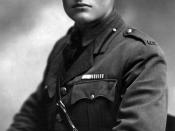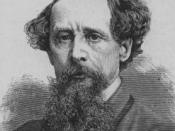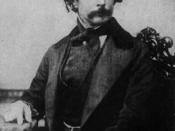Wuthering Heights, Emily Bronte's wildly passionate best-selling literary masterpiece, written in 1847, is still considered one of the greatest romantic books ever written about the eternal love between two soul mates, an adopted gypsy boy Heathcliff and manor-born Cathy.
The intensity of feeling between them defies the family barriers imposed by her brother after their father's death. Heathcliff is ill treated by the brother as he does not like him but Heathcliff bears the degradations well because of his love for Catherine and the minute they meet alone he forgets all the degradations and humiliations that her brother metes out to him. Even when Catherine grows old enough for the question of marriage to arise, her relationship with Heathcliff remains the same as when they were children.
My great miseries in this world have been Heathcliff"s miseries; my great thought in living is himself. If all else perish, and he remained, I should still continue to be; and if all else remained, and he were annihilated, the Universe would turn to mighty stranger.
I should not seem a part of it. (Bronte, Emily).
Then Catherine meets Linton, a rich man, compared to Heathcliff who is poor as a beggar, who also falls for her. She decides to marry him for all the practical reasons. But even with this decision of hers she doesn't forget Heathcliff
My love for Linton is like the foliage in the woods. Time will change it, I'm well aware, as winter changes the trees-my love for Heathcliff resembles the eternal rocks beneath-a source of little visible delight, but necessary. Nelly, I am Heathcliff-He's always in my mind-not as a pleasure, any more than I am always a pleasure to myself-but, as my own being-so, don't talk of our separation again-it is impracticable. (Bronte, Emily).
Although there are many different important messages in this novel, the main value is the changes that occur in and between the characters as in real life. Wuthering Heights is a love story that deals with the social classes and the suppression of true feelings. The characters within the story are truly fascinating, since they have numerous characteristic aspects.
As in reality it is not possible to only live for love, as love cannot sustain you, you need money for food and shelter as for other things in life. The decision that Catherine makes about marrying Linton makes sense because he had money and he could provide for her needs and she wanted to live like a true princess also which Heathcliff didn't have.
A Farewell to Arms by Ernest Hemingway is about an American Ambulance Driver, Frederic Henry, based in Italy during the First World War and how he falls in love with an English Nurse Catherine Barkley near the front between Italy and Austria-Hungary.
At first Henry's relationship with Catherine is an elaborate game based on his attempt to seduce her, but when he is wounded and sent to the American hospital where Catherine works, their relationship progresses and they begin a passionate affair.
After his convalescence in the hospital, Henry returns to the war front. Disgusted with the army and deciding to dessert his unit, as he has had enough of war; he dives into the river to escape.
"I did not care what I was getting into. . . . I did not love Catherine Barkley nor had any idea of loving her. This was a game, like bridge, in which you said things instead of playing cards. Like bridge you had to pretend you were playing for money or playing for some stakes. Nobody had mentioned what the stakes were." (Hemingway, Ernest; 31)
Social forms and conventions become extremely important as Henry and Catherine's sexual affair begins. The impropriety of their relationship is a source of danger; if their liaison is discovered, Catherine will be sent away. Helen Ferguson worries Catherine will become pregnant with an illegitimate child. For her part, Catherine seems even less concerned with social convention than Henry, dismissing his suggestion that they marry.
Propriety and social convention influence Hemingway's presentation of the love affair as much as they affect the actions of the lovers in the novel. The beginning of the affair is told only through suggestive dialogue, with no description--the standards of decency in 1929 America would have barred a more explicit version from appearing in print although it would not make any difference if written now. Nevertheless, the novel was plagued by charges of indecency--the sex scene was considered extremely raunchy, and the profanity in the novel caused a public outcry that led to the censorship of the novel.
A Tale of Two Cities by Charles Dickens opens in the troubled year of 1775, with a comparison of England and pre-Revolutionary France. It conveys the sense of doom and chaos. Both countries go through extreme social turmoil. With sarcasm, Dickens condemns the nobles as responsible for the disorder. The plot set up and characterization in the novel imply a sense of hope, a light in the darkness. The central characters in the book are all likeable people. Jarvis Lorry, the banker, is very reliable and responsive. He takes on a role of Lucie's friend and guardian. He is there to help and support her as they travel to Paris to find Mr. Manette, Lucie's father.
Under the guidance of [France's] Christian pastors, she entertained herself, besides with such humane achievements as sentencing a youth to have his hands cut off because he had not kneeled down to a dirty procession of monks. France rolled with exceeding smoothness down hill, making paper money and spending it. In England, there was scarcely an amount of order and protection to justify much national boasting. Daring burglaries by armed men, and highway robberies, took place in the capital itself every night. (Dickens, Charles)
Today, Lucie Manette would by no means be taken seriously as a believable, even likable character. She persists in fainting at particularly stressful moments, but when her husband is before a heartless, bloodthirsty jury, she looks brave and strong just for him. In context, this was a screaming contradiction, but one that Dickens required to portray his Eve. It is much easier to believe Madame Defarge's hate than her opposition's love. Defarge's sister was raped and murdered mercilessly and her brother was killed by a pair of heartless noblemen. It is much easier to understand Defarge's taste for blood than the condition of Manette, who, after practicing as a competent doctor and acting normally for years, experiences a recurrence of his mental condition simply because his wonderful daughter has left for two weeks, although he has two dear friends nearby.
Charles Dickens has built an enduring story enjoyed by millions, which is loved by experts and critics today although it would be immediately butchered if written by a modern author. It is a love story loved by its creator, but wholly unbelievable. It is actually doomed by its own idealism and unrealistic characters. As a hate story, it is much more competent, although also using this for its own purposes. One can draw one's own conclusions and ideas from such a book, but facts are facts.
Works Cited
Bronte, Emily, 1847. Wuthering Heights
Hemingway, Ernest, 1929. A Farewell to Arms Charles Scribner's Sons New York
Dickens, Charles. A Tale of Two Cities


